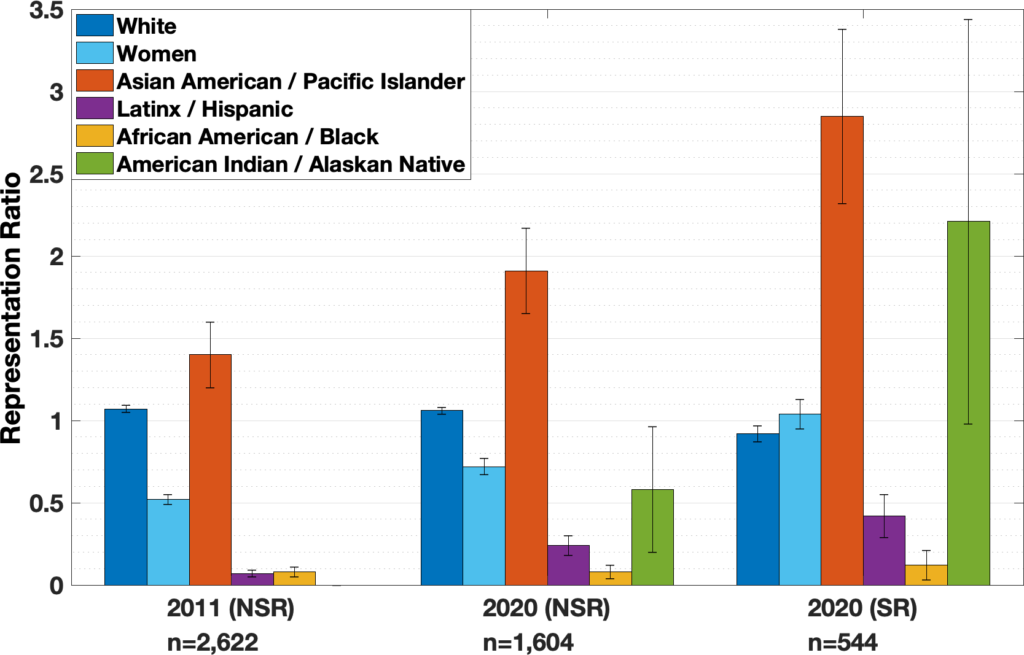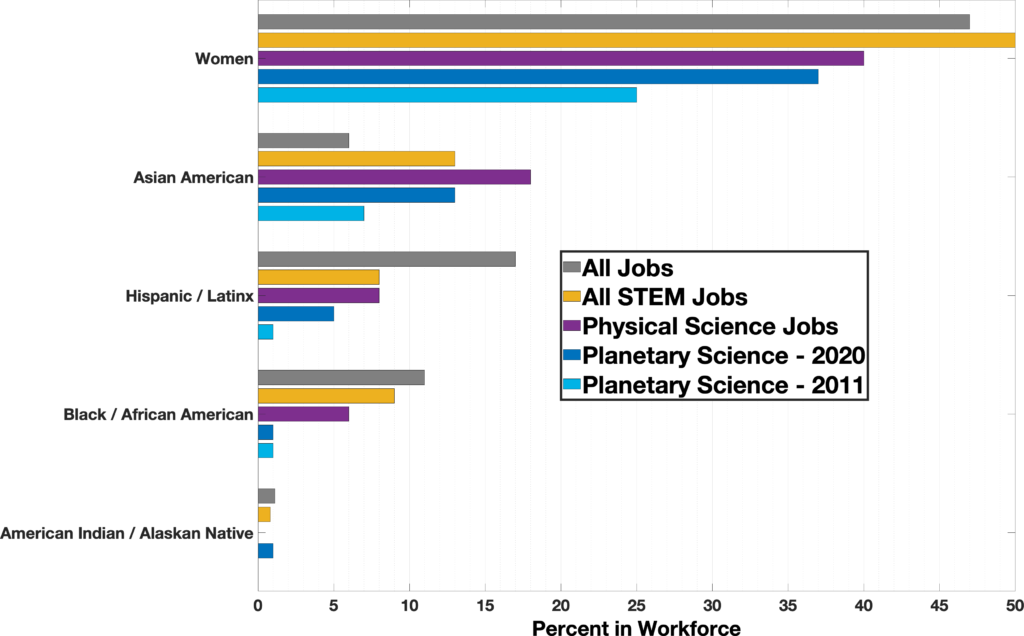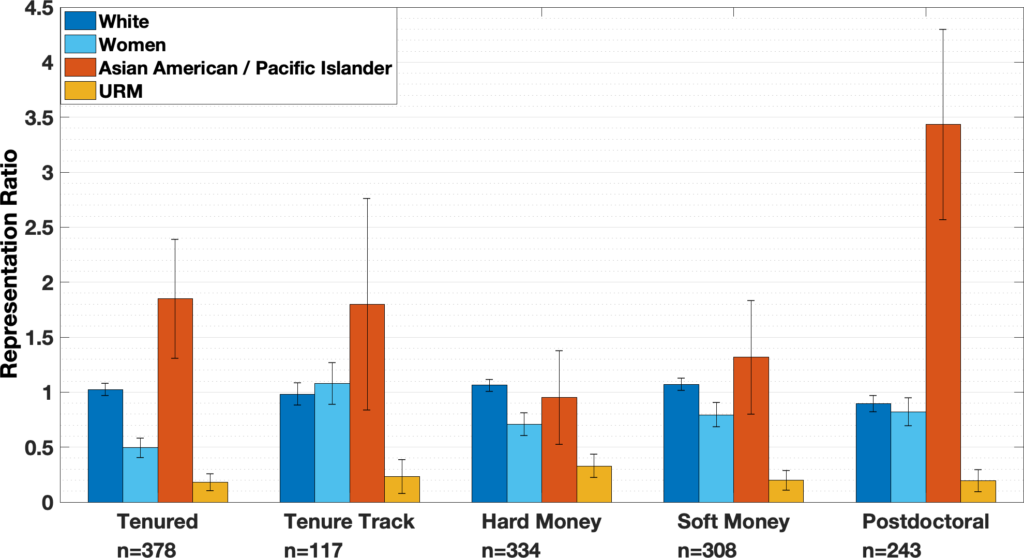
I live at the intersection of multiple historically excluded identities in our society, but I acknowledge that through my privilege I have avoided many experiences unique to others in our community. In acknowledgement of their added burdens, my empathy leads me to leverage my position, education, and privilege to help. I work to deconstruct the systems of oppression that have barred people from pursuing their passions, to educate others so that we can form an inclusive and welcoming community, and to listen and learn so that I can be a better ally and advocate.
I am an active member of several committees that advocate for an inclusive, diverse, equitable, and accessible profession:
- The Planetary Science and Astrobiology Decadal Survey State of the Profession Writing Group (SoPWG) is charged with recommending policies and practices to improve the state of the profession with an emphasis on issues of diversity, inclusion, equity, and accessibility.
- Along with Kennda Lynch, we convened the Advancing IDEA in Planetary Science Conference. The Consensus Report on recommendations from the conference is now available.
- I served as a reviewer for the National Academies’ report titled, Foundations of a Healthy and Vital Research Community for NASA Science.
IDEA White Papers
This is a list of workforce-related white papers submitted to the Planetary Science and Astrobiology Decadal Survey 2023 – 2032 that I participated in.
[7] Milazzo, M. et al. including Rivera-Valentín, E. G., 2021. DEIA White Papers for Planetary 2023 supported by the Cross-AG EDI Working Group. White Paper, BAAS 53.
[6] Radebaugh, J. et al. including Rivera-Valentín, E. G., 2021. The Value of a Dual Anonymous System for Reducing Bias in Reviews of Planetary Research and Analysis Proposals and Scientific Papers. White Paper, BAAS 53.
[5] Rathbun, J., Rivera-Valentín, E. G. et al., 2021. Who is missing in Planetary Science?: Strategic recommendations to improve the diversity of the field. White Paper, BAAS 53.
[4] Rathbun, J. et al. including Rivera-Valentín, E. G., 2021. Enabling the Planetary Workforce to do the best science by funding work that is a service to the Profession. White Paper, BAAS 53.
[3] Rivera-Valentín, E. G. et al., 2021. Who is missing in Planetary Science?: A demographic study of the planetary science workforce. White Paper, BAAS 53.
[2] Strauss, B. E. et al. including Rivera-Valentín, E. G., 2021. Nonbinary systems: Looking towards the future of gender equity in planetary science. White Paper, BAAS 53.
[1] Vander Kaaden, K. E. et al. including Rivera-Valentín, E. G., 2020. Creating Inclusive, Supportive, and Safe Environments in Planetary Science for Members of the LGBTQ+ Community. White Paper, BAAS 53.
Bridging Opportunity Gaps
In his book, How to be an antiracist, Dr. Ibram X. Kendi notes that the academic achievement gap is a racist idea. It fundamentally puts the onus on the people, or as he says it, “the test takers, as opposed to the test”. Dr. Kendi calls on us to instead look at the opportunity gap faced by underrepresented racial and ethnic communities. In my work and because of my experience, I endeavor to deconstruct systems of oppression by helping to bridge opportunity gaps.
I have worked on several initiatives to help bridge opportunity gaps for students:
- Along side the LPI education and public engagement team, we put together resources on how to write a competitive internship application. We have provided this seminar at SACNAS for the past two years.
- While at the LPI, we launched the LPI Intern Stories so others can learn from LPI summer interns about their preparation for their internship, their ongoing experiences, and how the internship has helped them.
- While at the LPI, I offered a Professional Development Seminar series to the interns, which included a seminar on applying to and what to expect in graduate school.
- While at the Arecibo Observatory, I managed the Arecibo Observatory Space Academy, an out-of-school time research experience for high school students in Puerto Rico.
Demographic Work
Demographic analysis of our field, as well as studies on decision making (e.g., grant selection), are mechanisms to hold ourselves, the community, and organizations accountable. Although such studies can help motivate diversity initiatives, they are not the only discussion point in diversity, equity, and inclusion.
I led a White Paper submission to the Planetary Science and Astrobiology Decadal Survey that analyzed the demographics of the planetary sciences, with a particular emphasis on trends over the past few decades. The data in this paper largely was sourced from the 2011 and 2020 surveys of the planetary sciences. Here I provide the figures as png files; they are also available on FigShare under doi:10.6084/m9.figshare.16550517.

Figure 1: Representation ratio for the demographics surveyed in the 2011 and 2020 planetary science workforce surveys for non-student researchers (NSR) and student researchers (SR). The representation ratio is the percent representation of the demographic in the field with respect to the percent of that demographic in the US Workforce for the same year. The x-axis label includes the year of the survey and the total number of respondents. Error margins are to a 95% confidence level and represent the survey’s ability to predict the demographics of the overall field. Note that no data was collected for American Indian / Alaskan Native in 2011.

Figure 2: Demographics, by women, race, and ethnicity, of the planetary science workforce from the 2011 and 2020 surveys compared to the demographics of physical science jobs, all STEM jobs, and all US jobs as reported by a Pew Research Center study. The percent representation here for the 2020 survey includes both student and non-student researchers. The data for American Indian/Alaskan Native is from a NASA report on the demographics of its workforce. Data is lacking for physical sciences and from the 2011 planetary science survey for American Indian/Alaskan Natives.

Figure 3: An intersectional look of gender and race of the demographics of the field as compared to the US workforce.

Figure 4: Representation ratio by job type as surveyed in the DPS workforce survey.
Key take aways:
- Black / African Americans are significantly underrepresented in the planetary science workforce at 1% compared to the US workforce at 11%, 9% of all STEM jobs, and 6% of physical science jobs. Over the past decades, Black / African Americans have seen no improvement in representation.
- Latinx / Hispanics are underrepresented in the planetary science workforce at 5%, compared to their representation in the US workforce at 17%, 8% of all STEM jobs and 8% of all physical science jobs. While their representation has improved over the past decade, it may only be tracking the population’s national growth.
- American Indian / Alaskan Natives are underrepresented in the planetary science workforce at 1% compared to 1.1% of the US Workforce. Diversity initiatives may be positively impacting American Indian / Alaskan Natives since they may be represented near or above parity in the group of planetary science student researchers.
- Overall, women are currently underrepresented in the planetary science workforce. Diversity initiatives may have positively impacted women over the past decades as they are at or near parity in the planetary science student researcher population, as well as the tenure-track faculty.
- However, Black, Latinx, and Indigenous women are significantly underrepresented in the planetary science workforce as compared to their representation in the US workforce. Latinas are 2.5% of planetary science compared to 9% of the US workforce. Women who are Black, Indigenous, or another race are 2.9% of planetary science compared to 7% of the US workforce.
